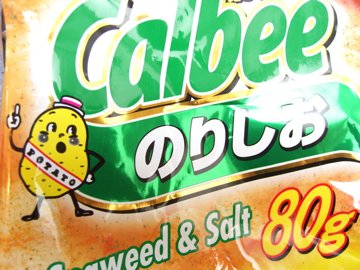
Eamon and Sakura — our son and his wife — are staying with us for a few weeks in transit from their two-year stay in Japan to their permanent digs over in San Francisco. They went shopping the other day at the Tokyo Fish Market here in Berkeley. Among other things they brought back from their expedition: an 80-gram bag of Calbee Seaweed & Salt potato chips (“Every time fresh Calbee Potato Chips now have the irresistible full flavor of Seaweed and Salt,” the package says. “Try it and add to your favorite shopping list today”). Calbee’s a Japanese snack food firm that the company history says started in Hiroshima after the war. In 1970, it opened up Calbee America and started marketing its products here; mostly, I imagine, in ethnic food stores like the Tokyo Fish Market.
For the record: The chips are great. Light. Not too greasy or salty. The seaweed flavor: subtle. Give me more than 80 grams next time.
But the arresting part of the Calbee chips experience for me: The appearance on their label of a cartoon character wearing a sash labeled “Potato.” He’s got an “uh-oh!” sort of expression on his face that seems less confident than you might wish for from a brand spokesman; he bears a cousin-ish relationship to Mr. Peanut, but without the monocular elegance or cane-inspired suggestion of swagger.
I’ve given this way too much thought.
Technorati Tags: berkeley

There is a whole “culture of cute” going on in Japan. Pikachu, Hello Kitty and anime are a few examples. I heard a pretty good critique of this on NPR’s “On the Media” show and while I may have mangled my understanding of what was said, a lot of this “cuteness” comes out of the post WWII trauma of defeat. Basically, a form of escapism. There are artists in Japan http://newyorkmetro.com/nymetro/arts/art/reviews/11707/ who have employed this cuteness in their work. In the case of this example, the show is entitled “Littleboy” and can be looked at this way just by taking in the cuteness the work. It also refers to the name the the A-bomb which was dropped on Japan in 1945. So the work references the definitive moment in modern Japanese history as well making a statement about the resulting culture which grew out of total destruction. That is the short explanation. As for me, even as a kid I thought there was more to Godzilla than a guy in a rubber dinosaur suit.
All this from a potato chip wrapper. BTW, he really does look like Mister Peanut.